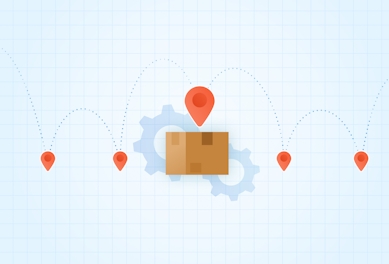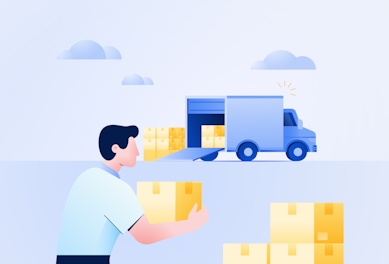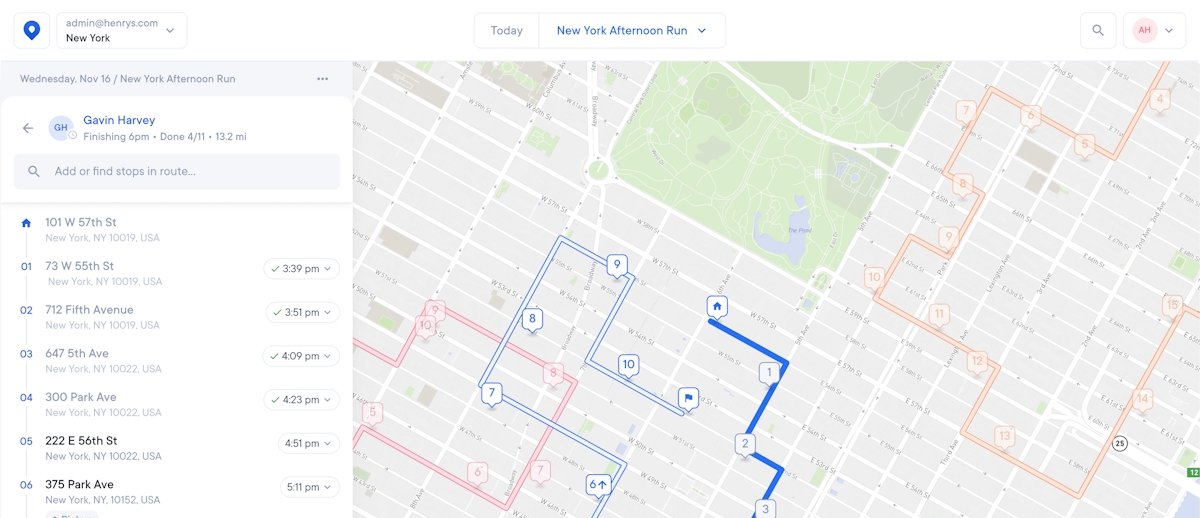A Guide to Cross Docking: Pros, Cons, and Tips for Success
Is cross docking the right solution for managing your logistics? This comprehensive guide will help you decide and show you how to do it right.
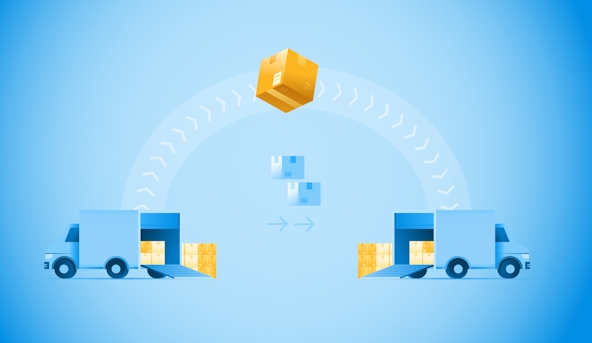
Circuit for Teams maximizes your shipping and delivery potential by letting you optimize and manage multiple routes and track deliveries to their destinations.
When it comes to warehousing and distribution, there’s a lot to consider to make the most out of what you’ve got.
Not only must you manage the limited storage space you have at your disposal, but you must also maximize how you use it. One way to do this is by cross docking.
For some businesses, cross docking can increase distribution efficiency and reduce operating costs. A study by the Institute of Physics discovered that a business could lower its warehousing costs by over 30 percent by properly implementing cross docking.
So, how does cross docking work, and how might it help your business?
In this article, we’ll walk you through the different types of cross docking and share some of the benefits and drawbacks that come along with it.
Key takeaways
- Cross docking streamlines your supply chain and logistics and frees up valuable warehouse space.
- Pre-distribution cross docking controls distribution centers and warehouses directly.
- Post-distribution cross docking is more flexible, relying on demand forecasting to determine where to ship inventory.
- Continuous cross docking is the most common type. Inventory flows through the docking facility from inbound to outbound vehicles — keeping food fresh for the supermarket industry, for example.
- Cross docking improves customer satisfaction by reducing transit time and meeting delivery schedules.
- Implementing cross docking can be tough, requiring you to purchase software and train employees to use it. But Circuit for Teams can help you manage the driver teams and delivery vehicles you need to make it work.
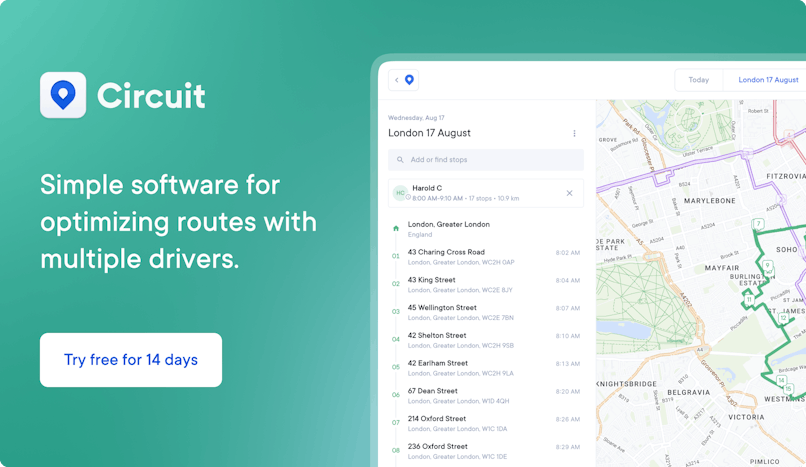
What is cross docking?
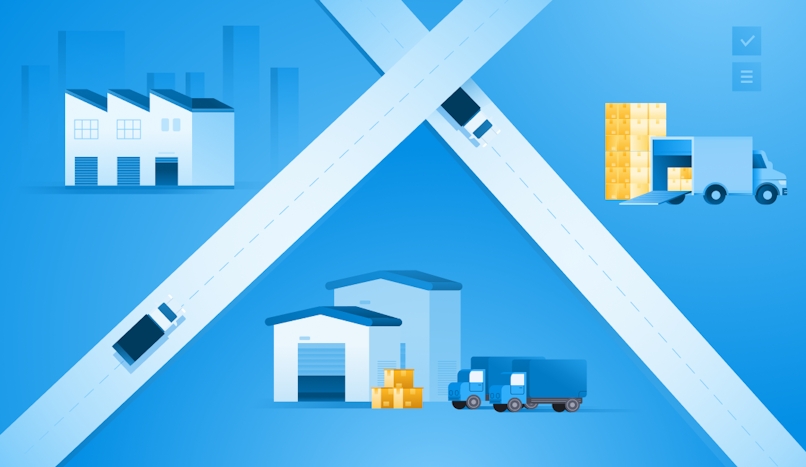
Cross docking is the process of unloading the contents of inbound delivery vehicles onto outbound trucks as quickly as possible. Here is how the process typically works:
When a delivery arrives, the receiving team unloads the materials from the inbound delivery vehicle. Then, the team sorts and stores them on pallets in a staging area until the items are ready to ship out again.
Once that time comes, the shipping team moves the items from the staging area onto an outbound vehicle, which takes them to their final destination.
Since the goods go right back out the door shortly after they arrive, this cross-docking system cuts storage time and frees up limited warehouse storage space for other shipments.
A cross docking facility can streamline your supply chain and logistics processes, saving time and money in the long run. Integrating a cross docking strategy into your inbound logistics process can keep your warehouse clear of inventory you otherwise may not have the room to store.
Businesses across a variety of industries can use cross docking to optimize both receiving and delivering goods. We’ll go over each one next.
Types of cross docking
Cross docking comes in many forms, each giving a different way of optimizing inbound shipments and outbound deliveries.
Let’s dive into the different cross docking methods and how some businesses successfully implement them.
Distribution
There are two main ways businesses implement successful cross docking strategies for distribution: pre-distribution and post-distribution.
Both methods involve delivering inventory to a docking station, warehouse, or distribution center, albeit with two major differences.
Pre-Distribution
With pre-distribution cross docking, the receiving team already knows where they’ll deliver the goods before they arrive at the distribution center.
Because the receiving team already knows where to send the goods beforehand, they immediately unload, sort, and repackage the items for delivery as soon as the shipment arrives.
Larger retailers often use pre-distribution cross docking to control their distribution centers and warehouses directly.
Since these companies have direct insight into what their suppliers send and what inventory their retail locations need, the distributor can pre-determine where goods need to go before they get them.
Walmart is one such retailer that uses a pre-distribution cross docking strategy. Before one of their stores gets a delivery, workers plan and allocate its contents based on what local customers want. This includes a bit of inventory forecasting.
Post-Distribution
With post-distribution cross docking, businesses use demand forecasting and current purchase orders to determine where to ship inventory after they get it. This type of cross docking is a bit more flexible for retailers and companies with products they need to move to various locations.
For example, let’s say you own a pharmaceutical company that stores prescription medicines and testing equipment in a main distribution center. You might hold those items in a cross-docking facility until you figure out which pharmacies need more inventory based on the number of customers needing each medication and how much each location already has in stock.
Manufacturing
The manufacturing industry often uses cross docking to get parts and materials to the facilities and customers that need them. When a manufacturing company gets an order, the product goes to a main distribution hub or docking station for sorting and delivery.
The receiving team organizes each shipment when it arrives, packaging each order separately and shipping it off for delivery to the customer or facility that ordered it.
Retail
With retail cross docking, a retailer gets multiple shipments from suppliers and consolidates them for delivery to their brick-and-mortar stores.
First, the retailer determines which items they want to stock. Then, they order these goods from their vendors, and the vendors ship the products to the retailer’s distribution centers.
The retailer then allocates the inventory for each store using metrics like inventory demand to determine which locations should carry it.
Best Buy is one example. The company sells everything from electronics to appliances in its nationwide retail stores, each of which may need different products.
Depending on each retail store’s location and what its customers buy, Best Buy determines what to ship to that store from its main distribution center.
However, since the company has multiple stores in each region, it might combine some of these shipments and ship them to a nearby cross docking station first. From there, workers will break down that larger delivery into smaller truckloads and send each of those to the appropriate store.
Opportunistic
Opportunistic cross docking is a dynamic way of determining whether cross docking a particular shipment is the best way to suit your and your customers’ needs.
It’s one of the more common methods of cross docking for just-in-time (JIT) manufacturing. This means a manufacturer makes just enough product to meet customer demand to avoid overproducing goods.
This type of cross docking is also common in flow-through distribution: a process involving a distribution center getting items from various places, sorting them by destination, and shipping them out on the same day.
Toyota Motor Corporation uses opportunistic cross docking to deliver items as part of their just-in-time (JIT) manufacturing process.
Since they only place orders for parts when a customer requests them, they’ll determine if cross docking is beneficial based on which parts need to be sent, where they need to be sent, and how they need to be sent.
Toyota then decides whether the situation presents an “opportunity” to use cross docking to optimize the delivery process based on this info.
Continuous
With continuous cross docking, inventory keeps flowing through the docking facility from inbound vehicles to outbound vehicles. This is one of the most common types of cross docking and is the quickest way to keep inventory on the move.
An inbound delivery vehicle arrives, and the receiving team gets to work unloading the shipment and prepping to move it to an outbound delivery vehicle. Then, the receiving team scans the shipment, puts it in a staging area, and loads it back up for delivery as soon as a truck or van is ready.
In some cases, the shipment doesn’t even make it to a staging area. It’s just moved directly onto another vehicle and sent on its way.
The supermarket industry is a great example of this in action. Since food must be delivered as quickly as possible to keep it fresh, shipments have to stay on the move to get there in time. Otherwise, the food can spoil before it even makes it to the store shelf.
In these cases, refrigerated trucks may be a much better place to store product than a warehouse that may or may not have cold storage.
Consolidation
Sometimes, a distribution center gets multiple inbound shipments from suppliers or manufacturers and combines them into one larger outgoing shipment for delivery. This is known as consolidation cross docking.
This method makes it easy for one location to get everything it needs all in one shot, instead of waiting for multiple deliveries to arrive.
Automotive assembly plants, in particular, can benefit from this consolidation arrangement. For example, Ford Motor Company worked with Penske to successfully implement this cross docking method.
Ford needs its suppliers to ship vehicle parts in smaller freight loads through “less-than-truckload” (LTL) shipments to each of their 30 assembly plants. So, Penske established ten dispatching centers to consolidate its parts shipments to Ford, effectively reducing plant inventory by around 15 percent.
Deconsolidation
Deconsolidation cross docking refers to when a distribution center gets a large shipment of products from a supplier, then breaks it into multiple smaller shipments for outbound delivery. It’s a great way to send large amounts of product from suppliers to multiple retail locations.
Most major retailers use this form of cross docking to split inventory up for delivery to their stores, but the Target Corporation offers a specific example of how you can implement deconsolidation cross docking.
Target’s distribution hubs get large deliveries from their suppliers, then break them down in what’s known as a “pick-and-pack strategy.” Deconsolidation cross docking turns those bigger shipments into smaller ones, which ship to each store based on demand.
Pros and cons of cross docking

While cross docking can benefit some, others may find it more trouble than it’s worth.
It can save time and money, but it also needs additional resources to manage properly and execute with minimal error.
Let’s take a look at some advantages of cross docking and some potential drawbacks to help you decide if it’s right for your warehousing and delivery needs.
Pros
- Less warehouse space needed: For most businesses using cross-docking warehouses, goods go from one delivery vehicle to another without sitting in the warehouse for very long. This helps make the most of warehouse space and cuts business costs.
- Faster product turnover: Cross docking allows inventory to spend as little as 24 hours in your warehouse — much less than the days or weeks that product might otherwise remain there before shipping to your end customer.
- Reduced material-handling cost: Handling these stored goods alone costs money since it includes equipment and labor. Cross docking helps move inventory out of your warehouse, so it needs less handling (and less handling cost).
- Reduced shipping cost: Cross docking can reduce shipping costs and handling costs for a number of reasons. Since most forms of cross docking consolidate multiple shipments into fewer deliveries, you’re spending less on labor and delivery costs.
This can reduce your number of deliveries, meaning fewer costs to get shipments out the door. - Reduced labor cost: A benefit of cross docking is that you usually just need a small dedicated team to unload shipments and load deliveries. A smaller team is both easier to manage and cheaper to operate, which can reduce your labor cost.
You can then pass those savings on to your customers or reinvest it into other areas of your operation - Improved customer satisfaction: Cross docking can help you get your deliveries faster by reducing transit time. The faster you can get your product, the faster you can meet customer demand and deliver their orders on time.
On-time deliveries are important for keeping your clients and customers on board with your service, and late or missed deliveries can cost you big time.
Cons
- Implementation challenges: Integrating cross docking into your warehouse operation isn’t always easy. It can also cost substantial time and money (and even more if done inefficiently).
You’ll need to make sure your warehouse team and fulfillment processes are equipped to handle quick delivery turnarounds, and that your systems meet the needs of a cross docking station.
Your suppliers must also be on board since they must make deliveries by a specific time so your drivers can get on the move as quickly as possible. - Relies on supplier relationships: Since cross docking is meant to get inventory moving quickly through your warehouse, things can start to fall apart if inbound deliveries are late, incomplete, or don’t show up at all.
Late deliveries can cost you big time, not just in terms of profit but also customer satisfaction.
For cross docking to work well in your warehouse, it’s imperative that your suppliers and delivery drivers are reliable and dependable. - Large initial investment: For cross docking to succeed, you’ll need the right shipping management software, a good team of drivers, and delivery vehicles in good working order.
Although the payoff can be great, these things can cost quite a bit of cash to get and maintain. So, be prepared to throw down the money needed to get your warehouse up to snuff. - Management requirements: Poor inventory handling can lead to delays in outbound deliveries or missed delivery times, so closely managing your fulfillment team is important. A properly trained team is the best way to make sure your cross docking process is in good hands.
Who should use cross docking?
Cross docking may not be for every warehousing situation and business type, but many find it’s a great way to reduce operating costs and improve efficiency.
In general, businesses moving a high volume of inventory are most likely to benefit from cross docking. But let’s take a look at some specific types of businesses it can benefit most.
Chemical companies
Chemicals often have special storage guidelines, which can be costly for a warehouse to implement.
With cross docking, a team can move these shipments through the warehouse without storing them any longer than needed to get them on a delivery vehicle.
These materials may need special delivery vehicles, equipment, or certifications. But the less time these chemicals spend on the road, the less risk your business poses to workers and the environment (and the faster they get where they need to go).
Automotive parts companies
As mentioned, large auto parts manufacturers like Toyota may use a just-in-time manufacturing model. That means they fulfill customer orders on an as-needed basis.
That’s why a cross docking strategy could benefit a business specializing in getting auto parts to mechanics and body shops. It can speed up turnaround times, getting ordered parts out the door and to their destinations quickly.
Pharmaceutical companies
If you’re in the business of delivering pharmaceutical and medicinal goods, cross docking may be a great way to speed up your deliveries, as well. Patients need these perishable goods as soon as possible, often by the next business day.
For example, a clinic may only order certain lab tests or medicines as their patients need them or when they run out of supplies. Cross docking shipments using a docking station near the clinic can ship these items more efficiently.
Food and beverage companies
Food has an expiration date. Delivering food as quickly as possible is important to prevent spoilage. That’s why cross docking can help food and beverage companies lacking the proper environment to store large amounts of these goods and their ingredients.
Cross docking can keep these things on the move (using refrigerated vehicles, for example) to improve supply chain management for companies that manufacture and sell food and drinks.
Cross docking done right

You must consider a lot to successfully implement cross docking. Everything from warehouse size and type to the warehouse management system (WMS) you use plays a part.
You’ll need certain automations and workflow optimizations that you don’t need for a traditional warehousing operation. And while you may have a good understanding of warehousing, cross docking has a few additional needs.
Use a transportation management system
Transportation management systems (TMS) are platforms that manage inbound and outbound shipping process logistics.
These play a vital role in optimizing the entire workflow of a warehouse or distribution center by optimizing processes, managing transportation costs, ensuring deliveries and shipments are compliant with regulations, and including shipping documentation.
They also offer transparency into how your company operates when it comes to shipping, helping you improve your cross docking strategy’s efficiency.
Organize a shipment staging area
Some cross docking shipments may not move from one truck to another immediately after arrival. This means they’ll need to sit in a staging area until a delivery vehicle is ready for loading.
Ideally, this staging area should be as close to the outbound doors as possible, minimizing how far the inventory needs to move.
Choose the right warehouse shape
Your warehouse’s shape plays a big part in whether cross docking will succeed. Goods needing to move too far or too often within the warehouse create more work for your team.
A rectangle with doors on each side is one of the best warehouse shapes for cross docking. This lets you move goods from the inbound side to the outbound side as quickly as possible.
Have enough cross docking terminals
If your warehouse only has one inbound dock and outbound dock, chances are cross docking may not work for you. Your warehouse needs plenty of doors to separate inbound and outbound shipments and keep them moving efficiently.
Use conveyor belts
Most cross docking stations use conveyor belts to quickly move smaller packages from the inbound dock to staging areas. These can increase your teams’ workflow speed by cutting unnecessary travel time across the warehouse floor.
Keep your warehouse clean
You’ll have a big problem if your fulfillment teams have to work around clutter or your forklifts don’t have enough room to maneuver.
There’s no use trying to implement a fast cross docking setup if goods can’t move through your warehouse. Make sure your staging areas and docking stations are in order and clutter-free, and your team always has plenty of room to move things around.
Make sure there’s plenty of space for trailers
An efficient cross docking system will have plenty of trailers and delivery vehicles moving through your docking station. Too little room for these truckloads to get to and from your docks means your shipments can get stuck waiting to be loaded or unloaded.
Make sure your warehouse has plenty of space for these trailers to move around, as well as plenty of spots to park them if they have to wait for pickup or delivery.
Is cross docking right for your business?
While cross docking operations aren’t always necessary for warehouse and delivery success, they can help it work better. Since it often needs some serious overhauls and investments to work properly, you’ll want to make sure it’s right for you.
To determine how cross docking can work for you in the long run, consider the size of your operation, your available warehouse space, how much money you can invest in this new system, and any changes you’ll need to make to implement it.
The right WMS and delivery management software, including a route planning and optimization solution like Circuit for Teams, can help make your cross docking strategy a successful one and make sure your customers get their orders on time.
Circuit for Teams lets you manage and optimize your delivery routes for shorter last-mile delivery times.

